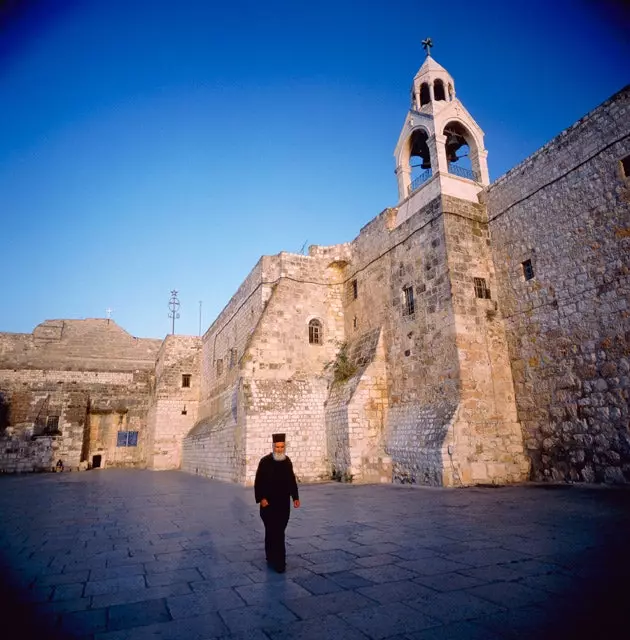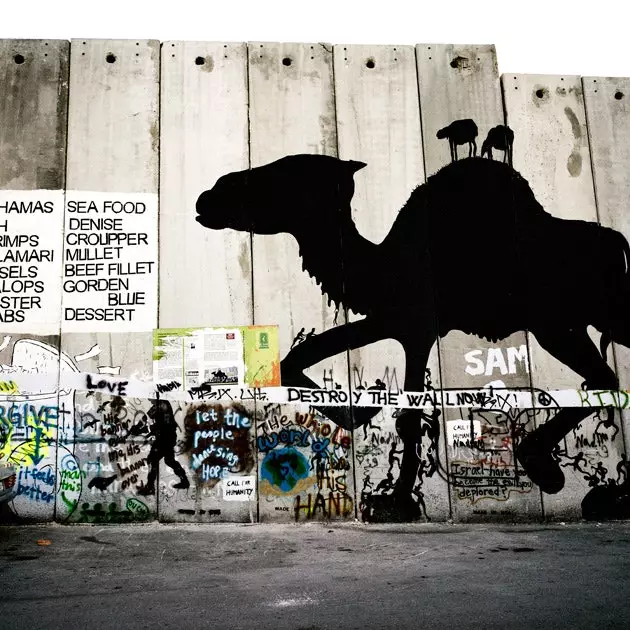
The exterior of the Church of the Nativity
“If the Three Wise Men came today to visit the newborn child, they would not be able to do so because they would find a great wall that would block their way” - Georges and Arlette Anastas, a Christian-Palestinian family whose house has been literally stuffed by the concrete wall built by the Israelis in 2004. Tragic circumstance that has served to inspire the best-selling object of Baptism garment, a small store specializing in objects of olive wood, which has been run by the family for decades. It is precisely a birth that represents the situation described above: a large wall stands between the portal and the wise men from the East, preventing them from entering . Few things could better explain the current panorama of the city.
But we will come back later with the story of Georges and Arlette because there are still many things about Bethlehem to tell beforehand.
Nestled in the Judean mountains and just 9 kilometers from Jerusalem, we arrived in Bethlehem on a sunny day in March. Gone is Hebron and its tragic beauty, the confused looks of those who cannot or do not want to understand. In the "city of bread" (meaning of Bethlehem in the Canaanite language) and, despite the grotesque presence of the wall, the atmosphere is much more relaxed: a charming cobbled center, a bustling market, its many churches, the mystical and religious atmosphere and the hospitality of its friendly people begin to remind us that it was here where it all began (at least for Christians).
Manger Square is undoubtedly the starting point for any exploration worth its salt. . In this square, the true nerve center of the town, stands the Church of the Nativity (prepared to give yourself a bump when you enter through the tiny door), one of the oldest churches in the world, built by Constantine the Great in the year 326 AD and that it is, above all, famous for containing **the exact place where Jesus Christ was born (skeptics, abstainers)**. In the so-called Grotto of the Nativity, which is accessed by stairs located in the central nave of the church, is the famous silver cross with 14 points that indicates with millimeter precision the point where the birth of Christ took place. You may not be religious (as I am), but nonetheless, in this slightly claustrophobic crypt packed with tourists, it's hard not to be moved by the weight of history and tradition.
Right next to this church we find another no less famous: The Church of Santa Catalina de Alejandría, where every December 24 the traditional Misa del Gallo is broadcast to almost everyone.
Not far from the hubbub of Manger Square our guide shows us The Milk Grotto Chapel . According to legend, Mary and Joseph stopped here during their flight to Egypt. A drop of milk fell on the reddish rock, turning it white. Since then, this small chapel has become a place of pilgrimage for those seeking offspring. To increase fertility, tradition dictates eating a little of the calcareous substance.
But to get to know Bethlehem, there is nothing better than strolling through its alleys, visiting its souk, the so-called "green market", full of typical products, and eating in one of its magnificent restaurants with reasonable prices, such as Afteem, very close to Manger Square, where you can taste the famous fatteh, a soup-like hummus topped with toasted pine nuts . And if the weather allows it, nothing like sitting on the terrace of the Casa Nova Palace Hotel, a Franciscan pilgrims' hostel located right next to the Church of the Nativity. The perfect place to enjoy a mint tea while watching the busy comings and goings of passers-by and the “frú-frú” of the religious robes of all possible confessions.

A fragment of the wall covered in graffiti
STORY OF A WALL
It is sad, but as in its day it was in Berlin, the wall of Bethlehem has almost become a tourist attraction . Impossible to ignore this huge 8-meter-high concrete barrier dotted with sensors and security cameras. And as it happened in that other equally famous one, creativity, artistic expressions and testimonies fill this wall of intolerance and exclusion to give it a new meaning: exceptional witness of an endless conflict.
But perhaps we should start at the beginning, what paints a wall here? In November 2000, then Prime Minister Ehud Barak approved the first project to build a barrier that would protect the Israeli territory of Palestine against the escalation of terrorist attacks . Construction of the wall, including land confiscation and deforestation, began in June 2002. By the summer of 2010, some 520 kilometers of the planned 810 kilometers had been completed. The economic crisis and international protests caused the construction to slow down from then on.
The truth is that as a result of this policy, a large amount of arable land and aquifers have been usurped from the Palestinians, not to mention the total isolation of at least 78 villages with a population of more than 250,000 people . There is no doubt that the attacks have decreased but at a price, in the opinion of some, that is unbearable for a people already impoverished and without resources and that, without a doubt, only fuels hatred and resentment against the Jews.
Suddenly, a woman urges us with great fuss to enter her house. She is Arlette Anastas, beautiful and easy-going: whether we like it or not, she is determined to tell us her story. And of course we want.
"One day my daughter came home from school and found a large wall a few meters from the house." The year was 2004 and the Anastas family ran a small but flourishing souvenir business a short distance from Rachel's Tomb. In just one day they were literally boxed in between two walls. The once light and airy house is now a dark and claustrophobic dwelling and the area that had been a bustling commercial street became an alley where few, if not by mistake (as in our case), would enter. But this old Christian family found new opportunities for their business on the internet , and although it has never been the same again, at least today it manages to support its own with dignity. Good for the Anastas, then.
In summary: mixed feelings, mysticism, hospitality, tradition … all this and much more is found in Bethlehem.
